Common menu bar links
Breadcrumb Trail
ARCHIVED - Canadian Institutes of Health Research
 This page has been archived.
This page has been archived.
Archived Content
Information identified as archived on the Web is for reference, research or recordkeeping purposes. It has not been altered or updated after the date of archiving. Web pages that are archived on the Web are not subject to the Government of Canada Web Standards. As per the Communications Policy of the Government of Canada, you can request alternate formats on the "Contact Us" page.
Section II: Analysis Of Program Activities By Strategic Outcome
Introduction
CIHR's Program Activity Architecture (PAA) is shown in Figure 1. The PAA consists of three Strategic Outcomes and the key program activities that support them. The performance information presented in the following pages is organized according to this structure (sub-activities are not shown in Figure 1).
Figure 1: CIHR's Program Activity Architecture (PAA)
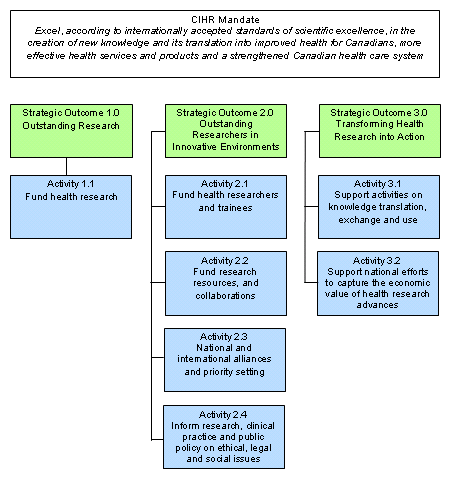
Note on Information Sources: The information presented in this DPR is based on a variety of sources.
CIHR's information system provides data on the number and value of project awards under the various funding programs.
A second source is the results of a survey of funded and non-funded researchers conducted for CIHR by EKOS Research Associates in February and March 2005. Both surveys involved structured telephone interviews. A total of 1,676 interviews were completed (a response rate of 56.3 %) with respondents coming from a broad range of disciplines and located across the country. This survey provides valuable information on the perspectives of researchers, a key group of stakeholders, towards CIHR's many activities. Further information on this survey can be found at http://www.cihr-irsc.gc.ca/e/31683.html.
A third source is the results of program evaluation studies conducted on CIHR's Institutes and programs. More information, including methodology and detailed results for these evaluations, can be found at http://www.cihr-irsc.gc.ca/e/31683.html.
A fourth source is the report of the IRP, published in June 2006. The executive summary of the report is included in Section IV, and more information can be found at http://www.cihr-irsc.gc.ca/e/31680.html.
Organization of Performance and Results Information
The following pages are organized by each of CIHR's three Strategic Outcomes. First, an overview of the Strategic Outcome and its indicators is presented, along with some macro-level performance data. Then each Program Activity under the Strategic Outcome is presented, with details on its planned and actual expenditure and performance rating, as well as highlights of some results for selected sub-activities. Finally, each Strategic Outcome section concludes with a summary of relevant risks and challenges.
CIHR continues to make modifications to the set of performance indicators used to monitor its various program activities and sub-activities. The performance indicators currently used are provided in a table under each of the following sections that describes a particular Program Activity. A crosswalk table comparing these indicators to the indicators used in the 2006-2007 RPP is provided under Section III: Supplementary Information.
Strategic Outcome 1.0: Outstanding Research
CIHR's Strategic Outcome 1.0 ensures that the: best health research is supported to create health knowledge responding to opportunities and priorities.
Enabling the conduct of outstanding research is the largest part of CIHR's core business. Throughout 2006-2007, CIHR continued to ensure that the best health research across all disciplines that are relevant to health was supported to create health knowledge responding to opportunities and priorities.
Three measurement indicators are used to monitor CIHR's performance against this strategic outcome:
- Canadian ranking in health research expenditures compared to international levels.
- Number of publications resulting from CIHR-supported research and their impact.
- Rating the quality of results of CIHR-funded research.
One of the key enabling inputs for health research is the amount available for investment. CIHR therefore monitors international trends regarding the level of investment in research in general and health research in particular. The number of publications resulting from CIHR-funded research is an indicator of the overall productivity of Canadian researchers. Finally, rating the quality of results of CIHR-funded research is an indicator of the quality of the outputs of investment in research.
It is important to note that CIHR is not the only organization that contributes to the achievement of this strategic outcome; therefore, CIHR does not claim direct attribution for the results.
1. Canadian ranking in health research expenditures compared to international levels
The Canadian government is the second-largest funder of general research and development (R&D) in Canada, behind the business sector. Since the end of the 1990s, federal expenditures have increased steadily, mostly through the funding of the higher-education system and via the federal granting agencies (CIHR, NSERC and SSHRC) as well as the National Research Council, Department of National Defence, Canada Foundation for Innovation (CFI), Genome Canada, etc. However, total government funding for R&D in Canada still trails the US and other major Organisation for Economic Co-operation and Development (OECD) countries.6 Recent OECD data show Canada currently ranks 12th out of 30 countries in terms of the share of GDP invested in overall R&D.7
Recent funding increases from the federal government have allowed Canada to assume a lead position among G-7 countries in terms of government health expenditures in R&D as a percentage of GDP. Overall, Canada ranks 4th behind the United States, United Kingdom and Iceland (Figure 2).8
Figure 2: Health-related R&D in Government Budgets (GBAORD1), 2004
As a percentage of GDP
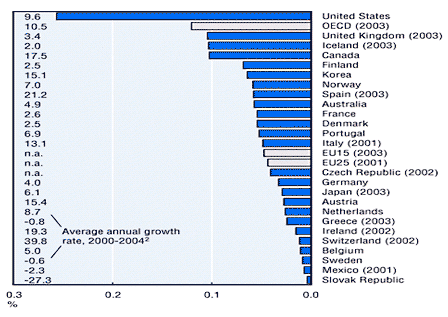
Source: OECD, Science, Technology and Industry Scoreboard 2005, figure A.8.
- "Government budget appropriations or outlays for R&D".
- Growth rate period is 2000-2003 for Greece, Iceland, Japan, Spain, Sweden, the United Kingdom and total OECD; 2001-2004 for Denmark; 2000-2002 for Ireland and Switzerland; 2000-2001 for Italy and Mexico.
6. "Science and technology Policy Documents", Science and Technology Data - 2004 available at http://strategis.ic.gc.ca/epic/internet/inrti-rti.nsf/en/te04319e.html.
7. See OECD, Main Science and Technology Indicators, 2006 http://www.oecd.org/dataoecd/49/45/24236156.pdf.
8. For further information, please see OECD Science, Technology and Industry Scoreboard 2005 - Towards a knowledge-based economy. Please note that the variance between placement of the UK, Canada and Iceland is very small at roughly .02 of GDP.
2. Number of publications resulting from CIHR-supported research and their impact9
Publications are a key output measure of the productivity of researchers and a primary method by which the results of research are translated into results for Canadians. There are two key factors: the overall number of publications, and the measure of the impact that they have.
As shown in Figure 3, the number of Canadian health research publications increased steadily from 1980 to 1999, leveling off to about 14-15,000 publications annually. The increased funding available during the first four years of CIHR's existence (2000 to 2004) has not yet resulted in a detectable increase in research output since most grants are three-to-four years in length and require approximately one year before results are published. However, the Canadian share of total health publications produced by the G-8 nations, which had been stable at about 6.4% between 1992 and 2000, started to rise in 2001, to reach 6.7% in 2004.
9. Please note that these data present general publication trends in Canadian health research and cannot be used to discern the specific impact of CIHR. While CIHR is the largest single Canadian health research funding agency, the trends described here also include research publications supported through other funding sources.
Figure 3: Number of Canadian Health Sciences Publications
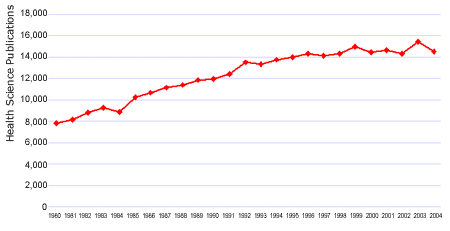
Source: Observatoire des sciences et des technologies; 25 years of Health Research in Canada : A Bibliometric Analysis, November 2005 (Commissioned by CIHR).
Overall, Canada produces approximately 5% of the world's publications in health research. Another way to compare publication rates that takes into account the relative capacity of a nation to support health research is to examine the ratio of publications to GDP. As shown in Figure 4, Canada's rate of scientific production is strong compared to the US and the European Union (EU) when the size of the overall domestic economies is taken into account. In fact, Canadian health researchers tend to produce more per dollar of GDP compared to health researchers in the US or EU.
Figure 4: Health Research Publications by GDP
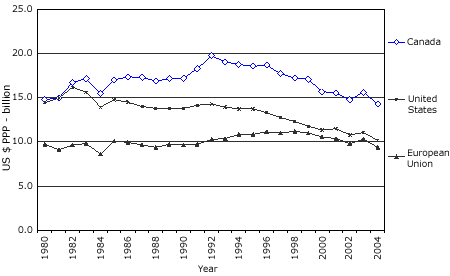
Sources: GDP data is from OECD database, US 2003 GDP data from national accounts data, Canada 2003 GDP data from Statistics Canada.
3. Rating the quality of results of CIHR-funded research
A useful measure of the quality of research funded by CIHR would be the degree of importance attached to the outputs of funded research by external experts. For example, we could compare the rankings generated by leading international health research journals from the review of publications produced from CIHR funded research, to the rankings of non-CIHR funded research. While CIHR intends to more systematically assess the quality of health research produced from CIHR-funded research projects, we acknowledge this will take some time to develop.
Performance at the Program Activity Level of the MRRS
The following sections describe each of the Program Activities that contribute to Strategic Outcome 1.0 and present the results achieved in 2006-2007.
Program Activity 1.1: Fund Health Research
Financial Resources (in millions)
| Planned Spending | Authorities | Actual Spending |
|---|---|---|
| $469.4 | $472.4 | $499.5 |
Human Resources
| Planned | Actual | Difference |
|---|---|---|
| 207 | 184 | -23 |
|
Expected Results Effective and efficient funding programs that enable ethical health research creating health knowledge that responds to opportunities and priorities. |
Indicators
|
CIHR supports the development of new knowledge through health research across all disciplines that are relevant to health. CIHR provides grants for both investigator-initiated and strategic research through competitions in conjunction with many partners.
Program Activity 1.1 Performance Status: Met Expectations
The following pages present a summary of the performance of two of the major sub-activities that support the performance status of Program Activity 1.1: Open Operating Grants Program and Institute Strategic Initiatives.
A. Open Operating Grants Program
The Open Operating Grants Program represents CIHR's single largest investment: in 2006-2007, CIHR invested $353.7M, which represents more than 50% of CIHR's total investment in grants and awards research (excluding Canada Research Chairs and Networks of Centres of Excellence). This open research support program encourages Canadian health researchers to pursue their very best ideas, define and pursue the mode of research best suited to advance those ideas, and pursue the opportunities most likely to advance the impact of their work.
Applications are accepted in all areas relevant to health and to CIHR's mandate and are funded according to their excellence as determined by peer review. There is a regular competition cycle with two application deadlines per year: September 15 and March 1.
The number of projects supported through CIHR's Open Operating Grants program, together with program expenditures for the period 2000-2001 to 2006-2007 are shown in Figure 5.
Figure 5: Number of Projects Supported and Expenditures of the Open Operating Grants Program
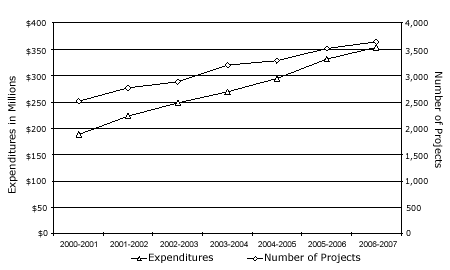
Source: CIHR Funding Database
Although more health research funding has become available to Canadian researchers, it has not necessarily become more accessible. Figure 6 shows the trends in the number of fundable10 applications to the Open Operating Grants Program that were not funded, compared to the number funded, over the period between 2000-2001 and 2006-2007. This may be regarded as one measure of CIHR's success: with its broadened mandate, it has stimulated applications from more researchers in all areas of health research.
10. CIHR has a rating scale of 0-5 for peer review of funding applications, and only applications rated 3.5 and above are eligible for funding.
Figure 6: Competitive Applications to the Open Operating Grants Program
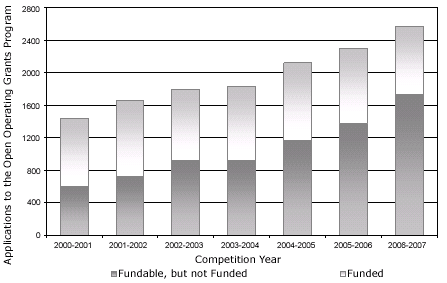
Source: CIHR Funding Database
Note: CIHR has a rating scale of 0-5 for peer review of funding applications, only applications rated 3.5 or higher are eligible for funding.
The Operating Grants Program was evaluated in 2004. The study was not able to assess the return on investment from funded projects, and therefore recommended that CIHR develop better ongoing performance measurement for the research funded by this program. Researchers surveyed by the evaluation stated that the program was a very important component of Canada's ability to generate highly qualified personnel. There were three main recommendations: develop better ongoing performance measurement for the program; review and clearly communicate the goals of the program in the context of other CIHR funding programs; and ensure that the peer-review processes do not unnecessarily disadvantage proposals from applicants who do not have an established CIHR track record, especially in nascent fields where capacity is developing and where researchers are attempting to address emerging issues of importance to Canadians. Since the evaluation was completed, progress has been made in implementing the study recommendations. For example, an electronic research-results reporting system is in development; a new electronic newsletter has been developed that identifies new developments regarding research funding; and work has commenced to improve the rating scale and criteria used by peer-review committees.
|
Cancer is one of the most devastating diseases facing Canadians Putting old drugs to new uses in the fight against cancer Diabetes and obesity gene presents new hope for breast cancer |
B. Institute Strategic Initiatives
The total expenditures of the Strategic Initiatives program were $95.2M in 2006-07. In deciding how to allocate these funds, the Scientific Directors and the Institute Advisory Boards are guided by the strategic plan of each Institute, CIHR's overall strategic plan (Blueprint11) and discussions with other Institutes and external partners and decisions by CIHR's RKTC.12
As noted above, a key indicator pertaining to the success of the Strategic Initiatives Program is the degree to which the Institutes have influenced research, policy and practice agendas in their communities. The two sources of information on this indicator are the results of the assessments conducted by the IRP and the opinions of our researchers and other key informants, including government policy makers and non-governmental organizations.
The IRP concluded that the Institutes "...have emerged as powerful components of the new vision of health research in Canada and, despite the limited resource available to them, have catalyzed a range of new initiatives in the health research arena in the country that are responsive to pressing problems. To have achieved the successful delivery of 13 such organizations must be seen as one of the most significant accomplishments of the CIHR."13
As noted previously, the most recent survey of researchers was conducted in 2005. We believe the results would change very little for 2006-2007, given the long-term nature of most research projects. Overall, more than one-third of funded health researchers (35%) stated that the Institute with which they were affiliated had been successful to a large extent in influencing the research agenda within its mandate, and 52% believe it had been successful to some extent. The detailed survey results are available at: http://www.cihr-irsc.gc.ca/e/30958.html.
11. CIHR's Blueprint for Health Research and Innovation: http://www.cihr-irsc.gc.ca/e/20266.html.
12. Prior to 2006-07, this committee was called Research Planning and Priorities Committee.
13. CIHR Year 5 International Review Panel Report 2000-2005, June 2006, p. 11.
|
Alzheimer's disease New developments in Alzheimer's disease When care is far away |
Risks and Challenges: Strategic Outcome 1.0
While the number of research applications has increased over the past several years, there is an increasing gap between the number of proposals submitted that are rated as excellent and the number that the organization is actually able to fund. As noted earlier in the section on risks and challenges, the inability of CIHR to fund all applications that are rated as very good, excellent or outstanding is a major concern.
Research is a long term endeavor and researchers require certainty that the funding provided by government will be available for the duration of the study. As a result, most of CIHR's grants and awards extend over a three to five year period which also implies that the majority of CIHR's budget in any given year must be set aside to meet the financial obligations created by approvals made in previous years. CIHR is required to manage research funding prudently and carefully consider the multi-year implications of its decisions to ensure that acceptable amounts of funding are available in all years to support approvals of new grants and awards.
As noted by the IRP, CIHR needs to collect more data on the results of funded research, to allow for more effective decision making in the future. CIHR is developing a "Research Reporting System" for all grant holders, which will capture information on the findings, outputs and, where possible, the outcomes of funded research. The new reporting system is planned for a phased-in implementation starting with the Open Operating Grants Program in 2008-2009.
The IRP also noted the need for more formalization of the responsibility of Institutes and the Institute Scientific Directors for research relevant to their Institutes that is funded through the Open Operating Grants Program. Benefits would include increased accountability over the appropriate allocation and distribution of resources between operating and strategic initiatives. CIHR established a new governance system, RKTC with the Institute Scientific Directors as members, to account for all research-related decision making within CIHR.
Strategic Outcome 2.0: Outstanding Researchers in Innovative Environments
Strategic Outcome 2.0 focuses on building a: strong health research community able to undertake outstanding research.
Developing a community of outstanding health researchers is another part of CIHR's core business. The main instruments used by CIHR to develop health research capacity in Canada are training and salary awards, Institute-led partnerships and ethical research standards.
CIHR uses several indicators to monitor long-term trends in this area, two such indicators being:
- Percent of PhD graduates in Canada planning postdoctoral fellowships in health.
- Quality and availability of adequate resources for research (e.g., infrastructure, hardware and software).
As noted earlier, indicators at the strategic outcome level are general societal indicators. Since these are longer-term outcomes to which CIHR, along with many other organizations, contributes, CIHR does not claim direct attribution to the results. CIHR contributes to the development of highly qualified personnel through direct investments in people via training and salary awards.
1. Percent of PhD graduates in Canada planning postdoctoral fellowships in health
The percentage of PhD graduates planning postdoctoral work is a key indicator of both the likelihood of PhD training encouraging individuals to continue in health research and the potential demand for CIHR postdoctoral fellowship awards. According to the 2005 Survey of Earned Doctorates, 56% of all graduates planned to enter the labour force after graduation, while 34% were planning to undertake a postdoctoral fellowship.14 However, for those graduating in the life sciences, approximately 64% were planning on continuing their training or study through a postdoctoral fellowship or other arrangement.
2. Quality and availability of adequate resources for research
The 2005 survey of CIHR-funded researchers found that 70% agreed that capacity in terms of research environments (infrastructure, hardware and software) is optimal to some extent, with only 8% saying it is optimal to a large extent. As Figure 7 demonstrates, researchers clearly identify capacity building as an area of high need; ranging from 88% (IPPH) and 89% (IHSPR) to 70% (IG).
Figure 7: Need for Institutes to Develop Capacity - Funded Researchers
"To what extent is the Institute needed in your field of research to support the development of Canadian capacity (in terms of people and research environment)?"
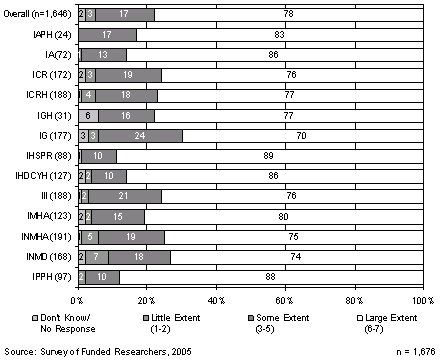
14. Data taken from Gluszynski, Tomasz and Valerie Peters, Survey of Earned Doctorates: A Profile of Doctoral Degree Recipients, Statistics Canada and Human Resources Development Canada, 2005, p. 14.
Performance at the Program Activity Level of the MRRS
The following sections describe each of the Program Activities that contribute to Strategic Outcome 2.0 and present the results achieved in 2006-2007.
Program Activity 2.1: Fund health researchers and trainees
Financial Resources (in millions)
| Planned Spending | Authorities | Actual Spending |
|---|---|---|
| $217.7 | $218.1 | $190.4 |
Human Resources
| Planned | Actual | Difference |
|---|---|---|
| 105 | 94 | -11 |
|
Expected Results Effective and efficient funding programs that ensure a supply of highly trained health researchers and trainees is available to conduct outstanding research. |
Indicators
|
CIHR utilizes individual training and awards programs, large group strategic awards and participation in the Canada Research Chairs, and Canada Graduate Scholarships programs, to assist in developing highly qualified talent and research capacity in Canada.
Program Activity 2.1 Performance Status: Met Expectations
The following pages present a summary of the performance of selected sub-activities that support the performance status for Program Activity 2.1.
A. Training and Salary Awards
A key instrument used by CIHR to develop health research capacity in Canada is training and salary awards. Figure 8 shows the number of people in health research across Canada who were supported by various CIHR awards programs in 2006-2007 (including the Canada Research Chairs, which is flow-through funding).
Figure 8: Research Capacity Building Support in 2006-07
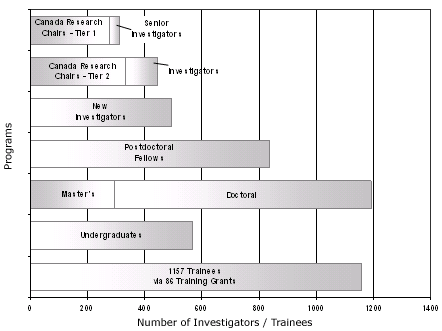
Source: CIHR Funding Database
Overall, expenditures in training and salary awards have increased between 2000-2001 and 2006-2007, but the trend over this period has fluctuated as shown in Figure 9.
Training award expenditures rose from approximately $33M in 2000-2001 to $49M in 2006-2007. Salary award expenditures rose from $29M in 2000-2001 to approximately $40M in 2004-2005 and then declined to $32M in 2006-2007 due to the termination of the Investigator, Senior Investigator, and Distinguished Investigator programs in 2003. Salary awards are also being terminated early due to the uptake of Canada Research Chairs (CRC) by recipients of CIHR salary awards. As per CIHR and CRC regulations, an individual may not hold a CIHR salary award and a CRC concurrently.
The 2005 survey of researchers provided feedback on the need for training grants and awards programs. Some of the findings were as follows:
- Researchers perceive a particularly great need for grants programs that fund training awards, grants and salary awards to help young researchers (88%).
- A majority of CIHR-funded researchers see a great need for the Institute with which they are affiliated to support the development of Canadian capacity in terms of people and the research environment (78%).
Figure 9: Expenditures in Training and Salary Support
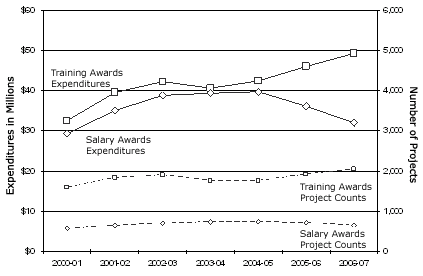
Source: CIHR Funding Database
Note: Salary Award figures exclude the Canada Research Chairs
B. Strategic Training Program
The most significant training program introduced by CIHR is the Strategic Training Initiative in Health Research (STIHR). STIHR supports innovative, interdisciplinary training through a block grant to a team of mentors, who must use at least 70% of the grant for the support of trainees. The program is delivered in collaboration with 15 partner organizations. Launched largely through the Institutes, it allowed those Institutes that had prioritized capacity development in their strategic plans to develop training programs in targeted areas.
In 2006-2007, CIHR provided funds to 86 STIHR grants, supporting an estimated 1,100 trainees. An additional 1,300 trainees participated in these training programs but did not receive a stipend directly. Examples of STIHRs include "Neurophysics: Setting New Frontiers in Neuroscience with Material Sciences and Photonics" at Laval University, and "Communication and Social Integration in Healthy Aging" at the University of Toronto, which links researchers from six different Canadian universities, and which won the American Psychological Association Award for Innovative Practices in Graduate Education in February 2005. The STIHR program is being evaluated in 2007-2008.
C. Canada Research Chairs
CIHR contributed $82.2M to the Canada Research Chairs (CRC) program in 2006-2007 to support 608 Chair awards in health research. The CRC initiative provides up to 2,000 Chair awards to excellent researchers in all disciplines, 1,000 each at the senior (Tier 1) and junior (Tier 2) levels. CRC funds are voted to CIHR by Parliament and specifically earmarked for this program. CIHR's Governing Council cannot divert these funds to other programs.
D. Canada Graduate Scholarships
The Canada Graduate Scholarships (CGS) Doctoral and Master's awards programs were introduced in 2003 by the federal government. These programs provide additional funding to CIHR specifically to support individual training awards for Master's and PhD level students. In 2006-2007 CIHR invested $10.1M in CGS to support 285 PhD students and 275 Master's students.
| Synapse The Synapse youth outreach program, intended to bring young people together with health researchers, got fully underway in 2006-07 and had a highly successful first year, eliciting a strong response from researchers and youth science organizations across the country. More than 2,000 researchers have registered as Synapse youth mentors, with another 700 expressing interest in the program. The first Synapse Mentorship Awards were announced in spring 2007. Other highlights of the first year include the appointment of a Youth Outreach Advisory Board and the launch of the Synapse website, with sections for both youth and researchers. Four new flash animations will profile CIHR supported health research for high-school students. |
Program Activity 2.2: Fund research resources, collaboration and other grants to strengthen the health research community
Financial Resources (in millions)
| Planned Spending | Authorities | Actual Spending |
|---|---|---|
| $73.2 | $70.4 | $66.2 |
Human Resources
| Planned | Actual | Difference |
|---|---|---|
| 31 | 28 | -3 |
|
Expected Results Effective and efficient partnerships and funding programs that lead to a dynamic research environment and outstanding research. |
Indicators
|
CIHR is strengthening the health research community's ability to conduct research by supporting research-enabling activities and resources. This includes supporting large teams of researchers from across disciplines in resolving some of the most complex health problems facing Canadians, engaging in collaborative activities such as networking and providing and maintaining state-of-the-art tools such as new equipment, databases and other specialized resources to conduct research.
Program Activity 2.2 Performance Status: Met Expectations
The following pages present a summary of the performance of selected sub-activities that support the performance status for Program Activity 2.2.
A. Team Grants
CIHR contributes funding to several team-related programs as part of its strategy to strengthen the research environment and enable outstanding research. In 2004, CIHR introduced the Team Grant program. It is designed to bring together researchers across multiple disciplines in order to harness their collective expertise to solve complex, multifaceted health challenges.
The expenditures of the Team Grants program in 2006-2007 were $17.4M. Through the second annual call for proposals, CIHR funded 19 projects selected from 49 applications received. The projects are focusing on health issues of high importance to Canadians. A third annual competition was also underway in 2006-2007, with bi-annual competitions planned thereafter. Once running at full capacity, it is expected that up to 100 teams will be supported, bringing together researchers from across multiple geographic and disciplinary boundaries. An evaluation of the Team Grants program will be scheduled within the five-year evaluation plan that will be prepared in 2007-2008.
| Preventing Injuries at Work Working in a fish processing plant is hard on workers' bodies. A multidisciplinary team of researchers from Memorial University and the University of Quebec at Montreal collaborated with workers, managers and the union at Beothic Fish Processors Limited in a CIHR-funded study to reduce the number and severity of work related musculoskeletal disorders among the workers. This was an innovative study of the health and safety risks faced by workers in a crab-processing plant, but that's not all that makes it unique. It combined a psychosocial survey, biomechanics research, participatory ergonomics interventions and a study of workers' strategies for coping with pain. It also included workers in the plant, their union and the plant's managers not simply as research subjects, but as full partners and active participants. This research is one of the studies undertaken by SafetyNet, a comprehensive research program examining the occupational health and safety of marine and coastal work that is led by Drs. Barbara Neis and Stephen Bornstein of Memorial University. |
B. Regional Partnerships Program
CIHR's Regional Partnerships Program (RPP) promotes health research in provinces that traditionally are not considered as being major centres of health research in Canada. CIHR, together with partners in these regions, co-funds applications submitted to CIHR that are shown to be fundable through CIHR's peer-review process, but are below the funding capacity of various CIHR competitions. The investment in the RPP was $3.5M in 2006-2007.
The RPP was evaluated in 2005. The evaluation resulted in the renewal of the program for two years, and a project was undertaken to update and renew the program objectives, eligibility criteria and partnership framework. It is anticipated that the revised program will be announced during 2007-2008.
Program Activity 2.3: Develop and support a strong health research community through national and international alliances and priority setting
Financial Resources ($ millions)
| Planned Spending | Authorities | Actual Spending |
|---|---|---|
| $28.2 | $28.1 | $23.3 |
Human Resources
| Planned | Actual | Difference |
|---|---|---|
| 12 | 10 | -2 |
|
Expected Results National and international health research agendas as well as strong alliances and partnerships are formulated and implemented. |
Indicators
|
CIHR is developing strong national and international partnerships, through CIHR's 13 Institutes, to advance strategic health research priorities and leverage funding and expertise for research. These partners include health policy makers at provincial, federal, and international levels of government, the private sector and voluntary health organizations from Canada and abroad.
Program Activity 2.3 Performance Status: Met Expectations
The major supporting activity is Institute Support Grants, whereby CIHR provides each of its 13 Institutes with a $1M support grant annually to facilitate and develop national research networks that link researchers. These grants support the operations of Institutes, including the salaries of Scientific Directors and Institute staff and other administration expenses. They also support Institute activities such as workshops and symposia that promote, encourage and support the research community affiliated with the Institute, and the Institute's research planning activities.
Mid-term evaluations of all 13 Institutes were completed in December 2005.15 The evaluations concluded that all 13 Institutes have succeeded in developing effective collaborations and partnerships. In fact, for some of the Institutes, partnership development was identified as their key strength. According to the stakeholders associated with each Institute who were interviewed during the evaluation, collaboration and partnership development has benefited the Institutes in several ways, including better coordination of research priorities and activities, enhanced capacity to develop common strategies to address areas of shared interest and, to some extent, the leveraging of additional funds.
15. Detailed Institute evaluations can be found at: http://www.cihr-irsc.gc.ca/e/31683.html.
Program Activity 2.4: Inform research, clinical practice and public policy on ethical, legal and social issues (ELSI) related to health and health research
Financial Resources (in millions)
| Planned Spending | Authorities | Actual Spending |
|---|---|---|
| $6.3 | $6.3 | $2.2 |
Human Resources
| Planned | Actual | Difference |
|---|---|---|
| 3 | 3 | 0 |
|
Expected Results Uptake and application of ethics knowledge as an integral part of decision-making in health practice, research and policy. |
Indicators
|
Planned Spending for Program Activity 2.4 was overestimated for the 2006-07 fiscal year. Activities that were properly attributed to another program activity were inadvertently included as part of ELSI. CIHR will ensure that planned spending levels for Program Activity 2.4 are more accurately presented for future fiscal years through the Annual Reference Level Update and Main Estimates exercises.
Broadly speaking, CIHR has two approaches to the ethical, legal and social issues (ELSI) of health. They center mainly around their relation to research on ethics, and ensuring ethics in research. Although ethics is cross-cutting at CIHR, with significant initiatives housed with individual Institutes, the Ethics Office is, for the most part, the hub of such activities.
In its Report on Plans and Priorities, CIHR has committed to promoting research on ELSI related to health, contributing to broader health policy debate and addressing allegations of non-compliance with research policies and governance of ethics on research involving humans. CIHR's expected result in this area is that uptake and application of ethics knowledge will be an integral part of decision making in health practice, research and policy.
Program Activity 2.4 Performance Status: Met Expectations
The following is a summary of the performance of selected sub-activities that support the performance status for Program Activity 2.4.
CIHR funds research on ELSI related to health and health research. In addition, CIHR engages in inclusive dialogue across all sectors, disciplines and communities, and pursues public engagement to improve knowledge and understanding of ELSI in the context of health and health research. In 2006-2007, CIHR invested approximately $1.8M to support ELSI-related grants and awards.
Since the release of the IRP report, CIHR's Ethics Office has undertaken and participated in several new activities to promote research in ethics and to demonstrate ethics leadership in Canada, including:
- Launching strategic initiatives that promote research in ethics (e.g., Ethics Seed Grants, which foster research in "ethics of health and health research" by building research capacity in Canada), as well as supporting three RFA-based research projects, six collaborative agreements and eight workshops.
- Supporting the development of an enhanced research oversight system through several initiatives, such as participating as a member of the Sponsors Table initiative and the Canadian Research Integrity Committee initiative.
- Developing a triage instrument to distinguish between public health activities requiring Research Ethics Board (REB) review and those not requiring this level of review; supporting a demonstration project for centralized ethics review of multi-centre trials.
- Promoting education in research ethics through funding to the National Council on Ethics in Human Research (NCEHR).
- In conjunction with NCEHR and the World Bank, delivering educational modules on research ethics to REBs in four Caribbean countries, through the facilities of the World Bank's Global Distance Learning Network.
|
Diabetes A possible cure for type 1 diabetes |
Risks and Challenges - Strategic Outcome 2.0
In delivering results related to Strategic Outcome 2.0, Outstanding Researchers in Innovative Environments, CIHR is presented with the following challenge:
Canada faces potential shortages in research personnel, given increasing demand for high-quality researchers around the world at a time of increasing rates of retirement among senior researchers.
This issue was identified in a recent Conference Board of Canada report card that assessed Canada's socio-economic performance.16 The report noted that:
Canada has a shortage of the skilled people who are essential for innovation. We have 7.2 researchers per 1,000 employees, compared with 16.5 per 1,000 in top-ranked Finland. Canada ranks 12th among the 17 comparator countries in the proportion of graduates with science and technology degrees.17
The risk of not adequately addressing this challenge is that Canada may lack the intellectual capital to conduct the research needed to support improvements in the health of Canadians and the health-care system. A shortage of personnel conducting research on new health products and services places Canadian economic competitiveness at risk.
To mitigate this risk, CIHR has made research capacity development a priority and has funded both individual awards and strategic health research training programs to address capacity gaps.
16. Conference Board of Canada, How Canada Performs: A Report Card on Canada, June 2007, available at: http://www.conferenceboard.ca/Default.htm.
Strategic Outcome 3.0: Transforming Health Research into Action
Strategic Outcome 3.0 focuses on ensuring that: health research is adopted into practice, programs and policies for improved health of Canadians and a productive health system; stimulation of economic development through discovery and innovation.
CIHR's KT strategy aims to accelerate the transformation of research results into health benefits for Canadians and an improved health-care system. This includes funding research on KT, synthesis and exchange activities and building KT networks. CIHR also plays a role in helping to move promising new research breakthroughs toward potential commercial applications.
Several key strategic outcome indicators are used to monitor CIHR's progress in this area, including the following:
- Extent to which CIHR-funded researchers are integrating KT targets into their work.
- Number and nature of patents, spin-off companies and licences for intellectual property generated from CIHR-funded research.
1. Extent to which CIHR-funded researchers are integrating KT targets into their work.
One indicator of progress in this area is the extent to which the nature of funded research is changing to incorporate, for example, a greater focus on KT. In the 2005 survey of researchers, when funded researchers were asked what percentage of their research projects can be described as having a significant KT component, a slight majority (58%) indicated that half or more of their research projects include KT activity and 19% reported that between one-quarter and half their projects include a KT component (Figure 10).
The survey of researchers also asked about CIHR's leadership in KT. Overall, 64% of funded researchers indicated that CIHR provides leadership in KT to some extent and 21% stated that leadership is provided to a large extent.
CIHR funds several programs that require decision makers as project team members, such as the Partnership for Health System Improvement. This program had expenditures of $1.1M in 2006-2007. KT plans are required and assessed and target audiences identified with an overall objective of improving the health-care system and health of Canadians.
Figure 10: Knowledge Translation as a Component of Research Projects
"What percentage of your research projects would you describe as having a significant knowledge translation component?"
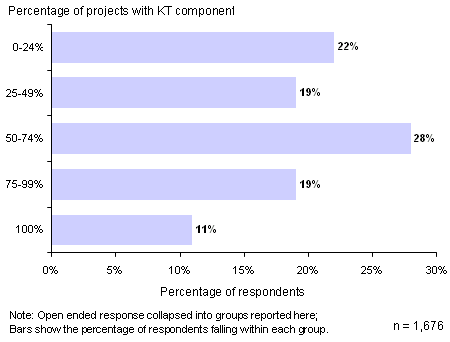
Source: Survey of Funded Researchers, 2005
2. Number and nature of patents, spin-off companies and licences for intellectual property generated from CIHR-funded research
As shown in Figure 11, between 1985 and 2000, there was rapid growth in the number of Canadian researchers receiving US patents in health sciences. The number of patents stabilized after 2000, but appeared to drop slightly in 2004. This may be due to increased maturity and sophistication of host institute technology transfer activities electing to be more discriminating and investing in only the most promising innovations with commercial potential.
Figure 11: US Health Sector Patents Held by Canadians, by Sector
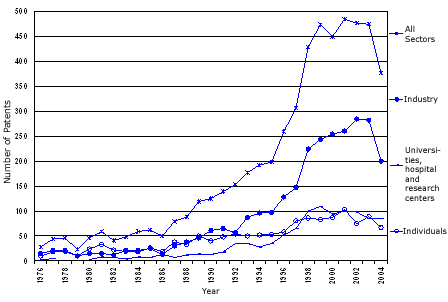
Source: Observatoire des sciences et des technologies; 25 years of Health Research in Canada: A Bibliometric Analysis, November 2005 (commissioned by CIHR)
Health research leads to new products, companies and jobs. By 2006-2007, federally funded research had led to 128 spin-off companies, 19 of which are publicly traded. Further details on the impacts of specific CIHR funding programs are provided later in this section.
| CIHR-Funded Research: Building Canada's Economic Strength A vaccine that fights E. coli in cattle has been authorized for use in Canada by the Canadian Food Inspection Agency. The vaccine was developed by Dr. Brett Finlay of the University of British Columbia and Dr. Andy Potter of the University of Saskatchewan and commercialized by Bioniche Life Sciences Inc., of London, Ontario. By preventing E. coli in cattle, the vaccine will also prevent its transmission to humans through meat products. |
Transforming Health Research into Action - Grants and Awards Expenditures
Figure 12 summarizes the grants and awards expenditures made by CIHR under Strategic Outcome 3.0 - Transforming Health Research into Action. Expenditures have grown substantially over the last six years, from $32M in 2000-2001 to $58M in 2006-2007. The Institutes have strongly supported KT research through strategic initiatives.
Figure 12: Grants and Awards Expenditures - Transforming Health Research into Action
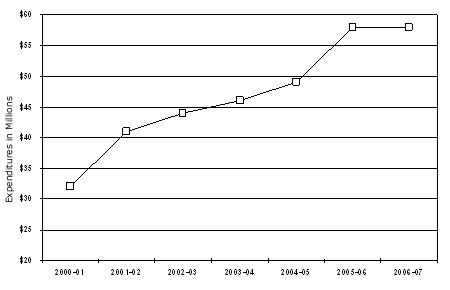
Source: CIHR Funding Database
Note: Includes Networks of Centres of Excellence.
Performance at the Program Activity Level of the MRRS
The following sections describe each of the Program Activities that contribute to Strategic Outcome 3.0 and present the results achieved in 2006-2007.
Program Activity 3.1: Support activities on knowledge translation, exchange, use and strategies to strengthen the health system
Financial Resources (in millions)
| Planned Spending | Authorities | Actual Spending |
|---|---|---|
| $40.7 | $40.8 | $35.0 |
Human Resources
| Planned | Actual | Difference |
|---|---|---|
| 20 | 18 | -2 |
|
Expected Results Effective dissemination, exchange, synthesis and application of research results take place to create new knowledge, strengthen Canadian capacity and networks and, together with our partners, enable effective research and application of health research results. |
Indicators
|
KT is about turning knowledge into action: translating the knowledge gained through health research into improved health for Canadians, more effective services and products and a strengthened health-care system. CIHR's KT strategy for 2004-2009 has four elements:
- Supporting research on KT concepts and processes
- Contributing to building networks of researchers and end-users
- Improving capability to support KT research at CIHR and with partners
- Supporting and recognizing KT excellence
CIHR continued to contribute toward the Networks of Centres of Excellence Program (NCE), in collaboration with Industry Canada and the federal granting councils (NSERC and SSHRC). NCE's are unique partnerships among universities, industry, government, and not-for-profit organizations aimed at turning Canadian research and entrepreneurial talent into economic and social benefits for all Canadians.
Program Activity 3.1 Performance Status: Met Expectations
The following page presents a summary of the performance of selected sub-activities that support the performance status for Program Activity 3.1.
The major activities undertaken in 2006-2007 under each of the four elements of the long-term KT strategy are as follows:
-
Support research on KT concepts and processes - Three annual strategic competitions for KT research have been held, and a peer-review committee for KT research has been established in the open grant competition. As a result, a permanent opportunity now exists to support KT research.
-
Contribute to building KT networks of researchers and end users - Non-government organizations and policy makers have been engaged with CIHR primarily through the Institutes, and the Vice-President of Research on national and international initiatives. The Institute of Health Services and Policy Research (IHSPR) and the KT Branch have led several projects designed to engage producers and users of knowledge, in order to improve policy, programs and practice. The wait times synthesis initiative and the adverse events research initiative are examples of this. The Partnerships for Health Systems Improvement Program is designed to engage decision makers in the research process to ensure effective uptake of the results of those jointly funded research projects. The Institute of Population and Public Health (IPPH) is directly engaged with policy makers by virtue of its Scientific Director being seconded one day per week to embed research thinking into the evolving Public Health Agency of Canada's National Collaborating Centre Program for Public Health and other initiatives.
Caf� Scientifique
CIHR presented its first-ever Caf� Scientifique this year. Caf� Scientifique is a place where, for the price of a cup of coffee or a glass of wine, anyone can come to explore the latest ideas in science and technology. The first Caf�, held in October 2006 in Ottawa, brought together researchers focusing on our aging brains, our aging bodies and the environments in which we're growing old. A second Caf� Scientifique, focusing on obesity, was held in March 2007 in conjunction with the Food for Health traveling exhibition, which opened at the Canada Agriculture Museum before embarking on a cross-Canada tour. CIHR is a sponsor of the exhibition. -
Improve capability to support KT research at CIHR and with partners - The KT Branch funds the production of research syntheses and scoping reviews where it is evident that these will be of use to policy makers, practitioners and other users of health knowledge. CIHR also funds the Canadian Cochrane Network and Centres, one of 12 independent, not-for-profit Cochrane Centres worldwide who contribute to systematic reviews of treatments used in health care. Systematic reviews are a reliable source of evidence to help people make well-informed decisions about health care.
-
Support and recognize KT excellence - At the annual Canadian Health Research Awards, CIHR presents an annual KT award to individuals, teams or organizations that make an outstanding contribution to the health of Canadians or to the health system through exemplary knowledge translation.
Program Activity 3.2: Support national efforts to capture the economic value for Canada of health research advances made at Canadian institutions
Financial Resources (in millions)
| Planned Spending | Authorities | Actual Spending |
|---|---|---|
| $27.3 | $27.3 | $26.7 |
Human Resources
| Planned | Actual | Difference |
|---|---|---|
| 12 | 10 | -2 |
|
Expected Results Implement strategies to enable the effective development and commercialization of health research that will lead to a better quality of life for Canadians through improvements in the Canadian health system, products and economy. As well, plan, launch and manage competitions and programs for grant funds to create and transfer new knowledge, strengthen Canadian capacity and networks and undertake effective commercialization of health research. |
Indicators
|
Commercialization is an integral part of CIHR's mandate. CIHR has various funding programs to support the implementation of its Commercialization and Innovation Strategy. The Strategy focuses on the early stages of commercialization, where there is a growing gap between a promising initial concept and its exploitation for health and economic advantage. CIHR's initiatives encourage and better enable universities and teaching hospitals to interact with partners from the public and private sectors that do late-stage development and ultimately deliver the benefits of health research.
The strategy has four components:
- Research - Building the research core to translate discoveries that will strengthen commercialization and the innovation pipeline.
- Talent - Developing the very best Canadian expertise in research, technology transfer, venture capital and business expertise.
- Capital - Facilitating the growth of high-risk small business through development of better-integrated, cohesive and knowledgeable capital.
- Linkages - Facilitating interactions between people and institutions at all stages of the innovation pipeline.
Program Activity 3.2 Performance Status: Met Expectations
The following pages present a summary of the performance of selected sub-activities that support the performance status for Program Activity 3.2.
CIHR's commercialization and innovation and industry collaborative programs are designed to encourage and enable the academic community to interact with Canadian companies with an interest in health research and development. These programs promote a wide variety of peer-reviewed research and training opportunities at eligible institutions that are jointly funded by CIHR and Canadian companies. The funding levels of the commercialization and innovation and industry programs are shown in Figures 13 and 14, respectively. The major achievements of some of the main commercialization and innovations programs during 2006-2007 were as follows:
A. Proof of Principle
CIHR identified a critical gap in funding at the early stage of commercialization, between the traditional role of granting agencies in supporting discovery research, and demonstration of "proof of principle" for an innovation, at which stage private-sector investment becomes interested. In 2001, CIHR filled this gap with the Proof of Principle (PoP) program, which provides two funding rounds to develop intellectual property with commercializable potential emerging from funded projects. The PoP program works with investigators and institutional technology transfer offices and funds peer-reviewed projects designed to strengthen intellectual property and improve successful identification and commercial development of health research discoveries and innovations. Applications are prepared jointly by the investigators and the institutional Technology Transfer Office, ensuring that the IP has been subjected to an initial technology assessment and selected for its significant commercial potential. To date, over 200 applications and $25.1M in CIHR commitments have been made through PoP. From the first three years of competition funding, 63% of funded projects resulted in a new patent being filed after receiving PoP funding (49 projects), 21% of funded PoP projects had IP licensed (16 projects), and 14% of funded PoP projects contributed to new company formation (11 projects).
| Realizing the economic benefits of CIHR-funded health research Amorfix Life Sciences Ltd., a Toronto-based company, was nominated as a Technology Pioneer 2007 by the World Economic Forum, the only Canadian company, out of a total of 47 nominees, selected for this year's award. Amorfix builds on the CIHR-funded discoveries of Dr. Neil Cashman of the University of British Columbia and Dr. Marty Lehto of the University of Toronto that will help to diagnose and treat neurodegenerative diseases such as Alzheimer's. |
Figure 13: Commercialization Program Expenditures, 2000-2001 to 2006-2007
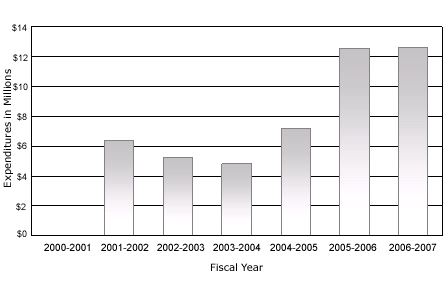
Source: CIHR Funding Database
Figure 14: Innovation Program Expenditures, 2000-2001 to 2006-2007
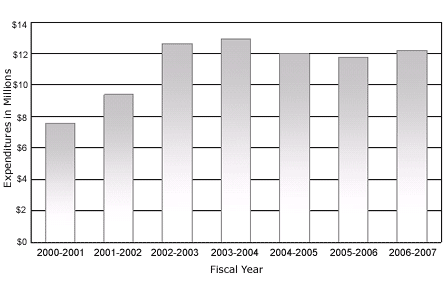
Source: CIHR Funding Database
B. CIHR/Rx&D Collaborative Research Program
The CIHR/Rx&D Collaborative Research Program promotes peer-reviewed research and enhances the training and development of health research personnel and opportunities in Canada. The program is an evolution of an existing partnership between the pharmaceutical industry and CIHR's predecessor, the Medical Research Council (MRC), that was originally established in 1993 (Phase 1). In 1999, MRC and Canada's Research-Based Pharmaceutical Companies (Rx&D) renewed the partnership (Phase 2). Many small Canadian biotechnology companies also benefited from and successfully grew under the first two phases of the CIHR/Rx&D Collaborative Research Program.
The agreement between CIHR and Rx&D for the third phase of this program, signed in October 2005, focuses on clinical research. The agreement is intended to enable scientists, clinicians and members of the full spectrum of health professionals to optimize their access to the unique opportunities and advantages offered by the emerging CIHR Clinical Research Initiative (CRI). The collaboration will enable the parties to maximize the impact of clinical and translational research in Canada in order to contribute to the health of Canadians, better delivery of health products and services as well as contribute to the economy of Canada. This realignment was successfully completed in February 2007 with the launching of the Clinical Research Initiative collaborative program with the CFI. The profound impact and contribution of this program to this national effort will be realized in 2007-08 and beyond.
CIHR and its partner organizations have invested over $150M18 between 1999-2000 and 2006-2007 for research funded under the CIHR/Rx&D Collaborative Research Program, approximately $40M of which was contributed by CIHR.
18. Currently, these figures represent only partner funds being administered by CIHR. As in-kind contributions can not accurately be validated and that partner funds not administered at CIHR are not included, partner contributions are likely understated.
C. CIHR/Small and Medium-Size Enterprise (SME) Program
Under this program, the industrial partner is a small or medium enterprise that is at the heart of the emerging biopharmaceutical industry in Canada. Eligible participants are not members of Rx&D. As with the CIHR/Rx&D Collaborative Research Program, the program supports a wide range of grants and awards, with fixed funding matches between CIHR's and the company's contribution to the costs of a research grant or award. Eligible participants may participate within and/or outside the Clinical Research Initiative.
Risks and Challenges - Strategic Outcome 3.0
In delivering results related to Strategic Outcome 3.0, Transforming Health Research into Action, CIHR is challenged by the need to work with the multitude of players involved in the process of innovation and the relative shortage of Canadians specialized in knowledge translation. The risk of inadequately addressing these challenges is that Canadians would not benefit as fully or as quickly as they should from the new knowledge produced through research. Other challenges include: influencing the use of research by end users is complex and can be a long process; there are insufficient resources and effort devoted to KT compared to knowledge generation (investigator-framed) activities; and there is a lack of capacity in KT researchers and knowledge brokers.
CIHR is responding to these challenges and risks through:
- producing and disseminating reports that synthesize research findings and convening symposia that bring researchers and policy makers together;
- promoting funding opportunities that encourage or require collaboration between decision maker stakeholders and researchers to ensure highly relevant and applied research is conducted in priority areas;
- recognizing dissemination activities in its evaluation processes for grants and awards, for example, by beginning to require that plans for dissemination and exchange of research findings be components of applications for funding;
- increasing support for programs that have a strong KT component, i.e., a direct application to health practices, policies or commercialization of health research findings; and
- supporting research advancing the science of knowledge translation.
